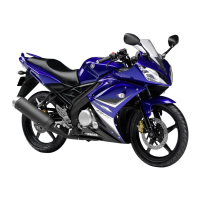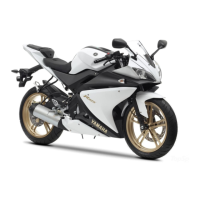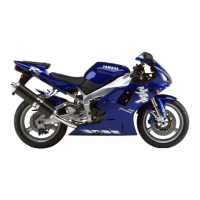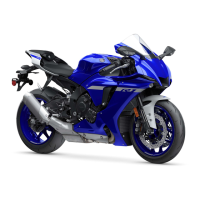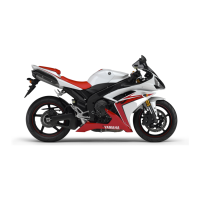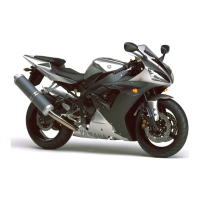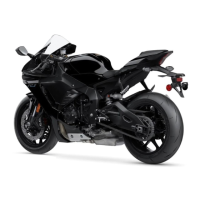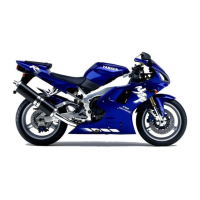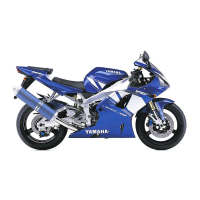Do you have a question about the Yamaha YZF-R1M and is the answer not in the manual?
Emphasizes owner's responsibility for safe operation and proper use of the motorcycle.
Details pre-operation checks, riding awareness, and avoiding hazards.
Explains the importance and use of helmets, face shields, goggles, jackets, etc.
Warns about carbon monoxide hazards and precautions.
Guidelines for adding accessories or cargo to affect stability and handling.
Identifies and describes the various controls and instruments on the motorcycle.
Explains the YRC system, its sensors, and automatic adjustments for riding experience.
Explains the immobilizer system to prevent theft by re-registering key codes.
Describes the main switch functions (ignition, lighting, steering lock) and positions.
Identifies and explains the functions of the left handlebar switches.
Identifies and explains the functions of the right handlebar switches.
Explains the various indicator and warning lights on the instrument panel.
Describes the two main display modes (STREET, TRACK) and items on the display.
Details the main screen information display, its groups, and items.
Lists and explains various error-related warning icons that appear on the display.
Details error mode warnings indicating system controller communication issues.
Describes the MENU screen and its setting modules for display and control adjustments.
Explains common wheel switch operations for accessing, selecting, and moving within the MENU screen.
Allows customization of YRC modes (MODE-A to D) and settings (PWR, TCS, SCS, LCS, LIF).
Explains the integrated ABS and UBS systems, their operation, and warnings.
Provides instructions and warnings for refueling and handling gasoline.
Explains the conditions and steps required to start the motorcycle's engine.
Explains how shifting gears controls engine power for acceleration and climbing.
Details the critical break-in period (0-1600 km) for engine wear and polishing.
Explains how to interpret maintenance charts and lists items requiring special skills.
Details maintenance intervals for emission control system components.
Lists general maintenance and lubrication jobs with their recommended intervals.
Details how to check spark plugs, their condition, gap, and replacement.
Explains how to check engine oil level and the process for changing oil and filter.
Explains how to check and change the coolant level and the recommended coolant type.
Explains the importance of checking and adjusting valve clearance for engine health.
Emphasizes tire condition, replacement, and air pressure checks for safety.
Details how to check front and rear brake pad wear using wear indicators.
Explains how to check brake fluid level, what low levels may indicate, and precautions.
Advises having the brake fluid changed by a dealer at specified intervals.
Explains how to check and adjust drive chain slack for proper operation.
Details the process for cleaning and lubricating the drive chain to prevent wear.
Introduces troubleshooting procedures for common issues like starting and power loss.
Provides quick procedures for checking vital systems like fuel, battery, ignition, and compression.
Provides warnings and steps to take if the engine overheats, including checking coolant.
Emphasizes owner's responsibility for safe operation and proper use of the motorcycle.
Details pre-operation checks, riding awareness, and avoiding hazards.
Explains the importance and use of helmets, face shields, goggles, jackets, etc.
Warns about carbon monoxide hazards and precautions.
Guidelines for adding accessories or cargo to affect stability and handling.
Identifies and describes the various controls and instruments on the motorcycle.
Explains the YRC system, its sensors, and automatic adjustments for riding experience.
Explains the immobilizer system to prevent theft by re-registering key codes.
Describes the main switch functions (ignition, lighting, steering lock) and positions.
Identifies and explains the functions of the left handlebar switches.
Identifies and explains the functions of the right handlebar switches.
Explains the various indicator and warning lights on the instrument panel.
Describes the two main display modes (STREET, TRACK) and items on the display.
Details the main screen information display, its groups, and items.
Lists and explains various error-related warning icons that appear on the display.
Details error mode warnings indicating system controller communication issues.
Describes the MENU screen and its setting modules for display and control adjustments.
Explains common wheel switch operations for accessing, selecting, and moving within the MENU screen.
Allows customization of YRC modes (MODE-A to D) and settings (PWR, TCS, SCS, LCS, LIF).
Explains the integrated ABS and UBS systems, their operation, and warnings.
Provides instructions and warnings for refueling and handling gasoline.
Explains the conditions and steps required to start the motorcycle's engine.
Explains how shifting gears controls engine power for acceleration and climbing.
Details the critical break-in period (0-1600 km) for engine wear and polishing.
Explains how to interpret maintenance charts and lists items requiring special skills.
Details maintenance intervals for emission control system components.
Lists general maintenance and lubrication jobs with their recommended intervals.
Details how to check spark plugs, their condition, gap, and replacement.
Explains how to check engine oil level and the process for changing oil and filter.
Explains how to check and change the coolant level and the recommended coolant type.
Explains the importance of checking and adjusting valve clearance for engine health.
Emphasizes tire condition, replacement, and air pressure checks for safety.
Details how to check front and rear brake pad wear using wear indicators.
Explains how to check brake fluid level, what low levels may indicate, and precautions.
Advises having the brake fluid changed by a dealer at specified intervals.
Explains how to check and adjust drive chain slack for proper operation.
Details the process for cleaning and lubricating the drive chain to prevent wear.
Introduces troubleshooting procedures for common issues like starting and power loss.
Provides quick procedures for checking vital systems like fuel, battery, ignition, and compression.
Provides warnings and steps to take if the engine overheats, including checking coolant.
| Bore x Stroke | 79.0 mm x 50.9 mm |
|---|---|
| Compression Ratio | 13.0:1 |
| Maximum Power | 147.1 kW (200.0 PS) @ 13, 500 rpm |
| Maximum Torque | 113.3 Nm (11.6 kg-m) @ 11, 500 rpm |
| Fuel Delivery | Fuel Injection |
| Transmission | 6-speed |
| Final Drive | Chain |
| Frame | Aluminum Deltabox |
| Front Tire | 120/70 ZR17M/C (58W) |
| Rear Tire | 200/55 ZR17M/C (78W) |
| Front Suspension | 43 mm Öhlins Electronic Racing Suspension (ERS) |
| Rear Suspension | Öhlins Electronic Racing Suspension (ERS) |
| Front Brakes | Dual 320 mm hydraulic disc |
| Rear Brakes | 220 mm hydraulic disc |
| Length | 2, 055 mm |
| Width | 690 mm |
| Seat Height | 860 mm |
| Wheelbase | 1, 405 mm |
| Minimum Ground Clearance | 130 mm |
| Fuel Capacity | 17 liters |
| Wet Weight | 202 kg |
| Engine Type | 998cc, liquid-cooled, 4-stroke, DOHC, inline-4 |
| Height | 1, 150 mm (45.3 inches) |

